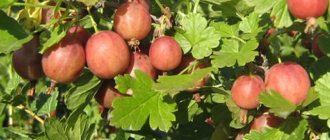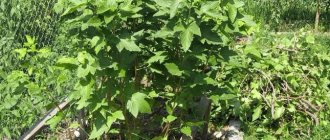Gooseberry Ural emerald: description of the variety
Photo of gooseberry Ural Izumrud
The Ural Emerald variety was created in the Chelyabinsk region; the famous breeder Vasily Ilyin worked on its creation. He created quite a few varieties of gooseberries, and this was one of the best. Two varieties of “Nugget” and “Perventsa Minusinsk” were crossed.
The foliage of the gooseberry variety Ural Izumrud has a dark, green tint. The leaf is not smooth, it has wavy edges and five lobes. The sheets are not all the same size; they can be small, medium or large, depending on weather conditions. They are very close together, creating a dense crown.
The height of the variety usually reaches about 150-180 centimeters; the shrub itself is not spreading and takes up little space, but at the same time it has a very dense crown. All shoots of the variety are straight and hard, usually green-brown in color and quite thin. There are very few thorns on the branches, they are soft and do not prick at all, so this variety is classified as a species without thorns.
Gooseberry flowers have a light pink or lilac hue and are small. Since the plant is bisexual, it does not require additional pollination.
The berries have the shape of a regular circle, sometimes they can be slightly elongated. The weight of the berries varies, it ranges from 4 grams to 9 grams. The pulp is dense, not watery, the seeds are small and black. The skin is thin and has no color; the pulp of the berries is visible through it. The pulp of the berry is very juicy and soft, and the berry also produces a pleasant aroma. 6.The taste of the berry is sweetish with a slight sourness.
The Ural emerald variety is suitable for the Urals and Siberia, since it was created precisely for these territories. Ilyin wanted to create a variety that would cope well with frosts and fairly severe frosts. Due to its peculiarity, it began to spread to other territories.
Note : Participating in the competition, this variety won in the nomination “The most unpretentious plant”, as well as “The highest resistance to diseases and pests”.
Description
Shrub of moderate size, dense, not too spreading. Thick gooseberry shoots grow upright and have shiny green bark with traces of anthocyanin coloring at the top. Along the entire length, the shoots of the Ural emerald are strewn with thorns, but, in general, the degree of thorniness is low. At the nodes the spines are one-, two- or three-parted, medium-long, straight, light brown, matte, located mainly perpendicular to the shoot, less often down or up to the shoot. Often the upper nodes, from 1 to 3, are completely devoid of thorns. The internodes of the variety are smooth, without spines. The oval buds are small, light brown, smooth, with a pointed tip, growing, deviating from the shoot. The petiole trace is rounded. Gooseberry leaves are of different sizes - from small to large, with a shiny and wrinkled surface, dark green, the leaf is concave along the midribs. The shape of the plate is five-bladed, the cutouts between the blades are of regular size. The middle lobe is higher in height than the lateral ones, the apices of the lobes are blunt. The midribs of the lateral lobes form an acute angle, the lateral lobes are not wide, of moderate length, directed slightly to the sides. The teeth are slightly bent, short or slightly longer, sharp. The basal lobes are underdeveloped. The base of the leaf can be either straight or convex. The petiole is green, long, thin. The inflorescences of the Ural emerald consist of one large, brightly colored flower. Sepals are not closed, reflexed, matte pink.
Gooseberry fruits are one-dimensional, medium or large in size - from 3.5 to 7.5 or 8 grams; according to the State Register, the usual berry weight is 4.3 grams. The shape is round-oval, the skin is thin, without pubescence, the veins are white. The variety got its name due to the color of the fruit - bright, green. The calyx is medium, half-open. The stalk is not long, moderately thick, green. The pulp is juicy, with a moderate amount of seeds. The taste is sweet or sweet and sour, rated as excellent - 5 points. 100 grams of raw material contains: sugars - 9.3%, titratable acids - 2.2%, ascorbic acid - 20.5 mg.
Frost and drought resistance
Its frost resistance can be explained by the fact that its parents also tolerated frost and drought well. The variety can withstand temperatures even lower - 34 degrees. If the frost reaches -40, the gooseberries must be covered so that they do not die.
The variety has a moderate tolerance to drought, but it is better not to tempt fate and water the plant well. Watering is directly related to the quantity and quality of the crop.
Note : A week before you are going to pick the berries, you need to stop watering. If this is not done, the berries will be sour.
What kind of yield does the Ural emerald gooseberry produce?
If you read reviews from gardeners, you can come to the conclusion that this variety is a high-yielding variety. Although it is bisexual and does not need pollinators, if you plant another variety next to it, they will pollinate each other, and the yield can increase by 35-45%. Sometimes plants have problems and are unable to pollinate themselves. Harvesting must be done several times. Since the variety is an early ripening variety, when at least half of the berries are ripe, you need to start picking. This will allow the remaining berries to ripen faster, since already ripe berries will not interfere with them. On average, one bush produces about 5-7 kilograms of fruit. The harvest is quite dependent on weather conditions.
Also, collecting already ripe berries will protect them from shedding. Ripe berries become heavy and cannot stay on the branch, and in the hot sun they begin to shrink.
Note : The berries can be stored for about 10 days in a fairly warm room, but if you want to preserve the berries longer, you should put them in a cold room.
Gooseberries are very healthy, so it is best to eat them fresh, since it is in this form that they are filled with the greatest amount of vitamins. When treated with hot water, vitamins disappear by 30-60% and the berries cease to have much energy value. When preparing various jams, preserves, the berries are boiled, and they turn out to be a strange grayish color.
Harvesting
The berries of the Ural emerald variety have excellent taste and a pleasant aroma, so they can be consumed freshly picked. In addition, compotes and juices, preserves and jams, as well as various medicinal infusions are obtained from them. Gooseberries can be canned and frozen. In this case, they are perfect for quenching your thirst.
The Ural emerald variety is highly valued for its high yield and excellent taste.
Since the variety is an early variety, harvesting occurs in late June - early July. From three to five and a half kilograms of berries are harvested from one bush.
To store gooseberries, containers of various capacities are required - this depends on the degree of ripeness of the fruit:
- At full maturity, the best option would be a basket made of chip tape, capable of holding up to 2.5 kg. They will be stored in a cool place for 4-5 days.
- If the berries are collected for speedy processing, you can use containers of larger capacity.
- Unripe fruits can be collected in containers with a volume of no more than five liters and stored for about ten days. At the same time, there should be no damage or moisture on them. If you take a container with hard walls, then the crop can be transported over a long distance.
It is better to collect gooseberries in dry weather, since berries collected after rain do not last long. Before storing, they must be spread in a thin layer for additional drying.
If you want to increase the shelf life of berries to one and a half months, you will need small baskets or boxes, a temperature of about 0°C and a relative humidity of 90%. Plastic bags will allow you to preserve fruits for up to 3-4 months at a temperature of -2°C
It is important to prevent the berries from fogging - to do this, they are pre-cooled in the refrigerator and then packaged in bags. When you want to extract the crop for consumption, first keep it at a temperature of 4-6°C for 5-6 hours, then bring it to room temperature
Disease resistance
The resistance of this variety to pests and diseases is quite high. But it is worth considering that if proper care is not carried out, treatment against pests, the choice of the right place and the right soil, then the gooseberry loses its stability and begins to suffer from septoria, anracnose, and powdery mildew. Or it is exposed to pests: aphids, spider mites or borers.
Diseases and pests, prevention
In rare cases, infection with anthracnose, septoria and attack by borers, aphids or spider mites is possible.
To avoid this, prevention is carried out. Spray early in spring and late autumn. To prepare the solution you need: 10 liters of water and one hundred and fifty grams of copper sulfate.
You can buy a ready-made product: Ridomil, Mospilan or Aktara.
It is necessary to remove weeds around the bushes, which provide shelter for insects. It is recommended to dig up the ground, sprinkling it with ash. Burn fallen leaves.
Gooseberry Ural emerald: pros and cons of the variety
pros:
- High level of productivity.
- Resistance to frost and frost.
- Adapts well in the regions of the Urals.
- With proper care, the plant can bear fruit for 17-20 years.
- Large and tasty fruits.
- Disease resistance.
- Fruiting does not depend on weather conditions.
- Small thorns that cannot harm a person when harvesting.
- Unpretentiousness.
- Long shelf life, while maintaining all taste and appearance.
- It tolerates transportation well even over long distances.
Minuses:
- Unstable harvest. That is, in the first year it can be 5 kilograms, next year 7 kilograms, and then again 5 kilograms.
- Needs watering due to very dense crown.
a brief description of
Most of all, gardeners' attention is attracted to the variety by its high yield (up to 6 kg per bush, 7-18 t/ha) and amazing resistance to most diseases of berry crops (primarily to the “troubles” of all gooseberry varieties - powdery mildew and anthracnose). However, the Ural emerald has other pleasant features.
Advantages of the variety
- unpretentiousness to growing conditions;
- long fruiting period - up to 20 years;
- early ripening – end of June (Central region);
- delicious, versatile berries;
- When ripe, the fruits do not create problems with harvesting: they do not fall off and are easily removed from the stalk;
- not susceptible to attack by insects - sawflies and moths;
- high winter hardiness - up to 30 degrees below zero;
- Good survival rate of green cuttings.
Disadvantages of the variety
- declared yield 6 kg. and more can only be obtained on fertile soils;
- presence of thorns;
- like all other gooseberry varieties, it does not tolerate waterlogging and too dry soil.
A solid list of advantages and only 2 “disadvantages” will not prevent a real gardener from getting the maximum result from the variety.
Planting a variety
When planting gooseberries, certain rules must be followed. It is better to plant gooseberries with other crops, as this will allow the plant to be better pollinated.
The variety should be planted in mid-September. The seedling is either grown yourself, or you can buy Ural Izumrud gooseberries in a specialized store. In order to prepare the seedling yourself, you must already have an adult bush. In spring, you need to dig in several cuttings that are already a year old. During the summer period they will begin to grow and roots will appear. A seedling already with a good root system is transplanted separately.
Note : When planting gooseberries, you need to take into account weather conditions. The best choice would be 18-20 days before the first frost. During this time, the plant will be able to adapt and take root.
Requirements for planting and care
Planting is carried out in spring or autumn, the main thing is a month before the first frost, so that the roots have time to take root.
Action plan:
- The hole is prepared 14 days before planting. Depth and width fifty centimeters.
- Top soil is taken and fertilizers are added: 250 grams of superphosphate, forty grams of potassium sulfate, 20 liters of humus.
- Everything is mixed and poured into the center.
- When planting, the roots are straightened and evenly covered. The plant is watered.
- Mulch with humus or peat.
- Plant the crop in the sun.
Care consists of the following procedures: rationing, fertilizing, watering (carried out a couple of times during the summer, about three buckets of water are poured out at a time), weeding and pruning.
Let's watch the video and use tips on caring for the plant and pruning it:
Landing place
The Ural emerald variety is a light-loving variety, so the place should be well lit by sunlight. Exposure to the sun will allow the plant to protect itself from diseases and produce the highest possible yield. If the gooseberry was planted in a lowland, then with such planting it loses 20-30% of the yield, and with this arrangement, fungal diseases attack the plant.
This variety is not afraid of temperature changes, but with a lack of sun it becomes uneasy. The composition of the soil is also very important for gooseberries; for good development, they must be transplanted into soil with low acidity, which has a lot of nutrients. In swampy soils, gooseberries will die and will not be able to thrive.
Agricultural technology for growing gooseberries
When growing Ural emerald, take into account the recommendations of experienced gardeners:
- The shrub is not afraid of wind and loves sunlit areas. In the shade, the yield is significantly reduced;
- He needs fertile and moderately moist soil;
- Young seedlings are planted in the fall, and propagated in the spring;
- Care includes watering, pruning and fertilizing. Fresh manure cannot be used as fertilizer;
- Neighboring gooseberry bushes of other varieties will help increase productivity.
Landing
Gooseberry Emerald is not afraid of fluctuations in temperature and wind, but it loves loose soil and good lighting. The place for it is chosen on the plain; lowlands with stagnant water and elevation are not suitable. The best planting time is September-October, depending on the climate and weather. The shrub must have time to take root before frost.
Shrubs of the Ural emerald
For propagation in the spring, the cuttings are bent to the ground, secured and covered with earth. By autumn they will take root, and they can be separated and transplanted to a permanent place. When planting, humus and ash are added to the hole. If the soil is poor, dig a large hole and fill it a third with humus and compost mixed with soil removed from above. Add a glass of ash. The shrub is not afraid of being buried, this only benefits it: the side shoots, once in the ground, quickly take root. When planting in spring, add 100 g of urea or 500 g of complex fertilizers, but not into the hole, but from above under the bush, otherwise they will go down with watering, and the roots will not get anything. Make a roll of soil near the newly planted bush to retain water and water it well.
How to care for Ural emerald
Care consists of the usual procedures for all berry crops. The variety is resistant to major diseases and only needs pruning, watering, fertilizing and weeding.
Caring for gooseberries in spring
In summer, potassium and phosphorus are added under the bush. Urea is used 3 times per season at weekly intervals. It is diluted with water and 2 buckets are poured under each bush. If a cold winter is predicted, the bushes are fed with nitrogen in the fall.
Gooseberries are watered 2 times a week, using one bucket for each bush in the morning and evening. The shrub especially needs watering during fruiting in July-August. At this time, flower buds are also laid, which are responsible for fruiting next year. Lack of moisture will affect the harvest.
They carry out sanitary and anti-aging pruning of bushes. Pruning should prevent crown density and increase yield. Berries are formed on branches for up to 7 years, then their number decreases.
After this there are 2 ways:
- Remove the bush and plant a new seedling;
- Rejuvenate gooseberries by pruning.
Depending on the density of plantings and the distance between plants, from 8 to 20 branches are left in the bush. First of all, old branches that interfere with the growth of young growth are removed. 6 years after planting, 2-3 shoots are removed from the bushes every year. Instead, a young shoot grows, and the yield remains at the same level without decreasing.
Growing fluffy Espostoa cactus on a windowsill
Diseases and pests
Diseases and pests do not bother the Ural emerald much, but preventive measures still need to be taken.
In early spring after the snow melts and late in autumn, comprehensive protection is carried out by spraying with copper sulfate. Watering should be plentiful so that, flowing down the branches, the solution destroys pests and their larvae.
For the prevention of diseases, the drug Radomil is used.
Attention! For gooseberries, you cannot use preparations containing sulfur; it is harmful to the bush.
Prevention activities include:
- Weeding. Weeds can harbor harmful insects;
- Spring and autumn digging of the soil around the bushes with the addition of ash;
- Pruning and burning dry branches;
- Destruction of fallen leaves.
Harvesting and processing
Emerald berries have a unique taste and amazing aroma. Children enjoy eating them fresh straight from the bush. Refreshing compotes are made from gooseberries, sealed in jars for the winter in the form of jam and preserves, and the juice is squeezed out. Gooseberries can be frozen.
Branch of Ural emerald gooseberry
It is collected only in dry weather. Fruits collected after watering or rain have a reduced shelf life. For transportation you need containers with thick walls.
Planting material
The cutting must meet certain criteria:
- The cuttings should have 3-5 shoots.
- The cuttings must be trimmed.
- The buds that are on the cuttings must be intact.
- There should be healthy, clean foliage.
- The roots should not be dry.
- The trunk bark should be smooth.
Before planting, seedlings of this variety must be disinfected using a manganese solution.
How to plant gooseberries Ural emerald
The landing must be correct and performed according to specific instructions.
- Prepare the planting site by digging up the soil at the site and removing all weeds and debris.
- Dig a hole for the seedling, about 65 centimeters deep, about 50 centimeters in diameter.
- At the very bottom you need to lay out a layer of ash, about 250 grams.
- Place the seedling in the hole and distribute the roots throughout the hole.
- The shoots must be separated so that they do not touch each other.
- Cover the seedling with soil and compact it a little.
- Water generously.
- The buds on the lower branches of the cuttings are cut off.
Planting young seedlings on the site
In general, planting is done in the same way as planting other varieties, but there are several nuances that you should know about in advance.
Selection and preparation of seedlings
Gooseberry Consul - features and characteristics of the plant
For planting, you need to select high-quality healthy seedlings. It is best to purchase them in centers or large farms that specialize in breeding this variety.
Time and landing pattern
Since this variety is considered medium-spreading, you can plant several bushes next to each other in one area; they will not interfere with the development of plants. Moreover, along with self-pollination, cross-pollination will occur, and this will increase the yield.
Interesting! The best time for this is considered to be autumn, and in central Russia this is the period from late September to mid-October. But, of course, you need to focus not only on the calendar, but also on the weather forecast. Bushes should be planted before the first frost (about three weeks). Then they will have time to take root well and survive the winter well.
Choosing a landing site
This variety of gooseberry prefers open and well-lit places. At the same time, it is resistant to temperature changes and wind, so choosing a suitable site for it is not so difficult. The only difficulty is that this gooseberry is demanding on the soil, and a good harvest can only be obtained on loose loam.
But the humidity level should be moderate. Therefore, planting bushes in lowlands is not recommended. At higher elevations, the plant may lack moisture, but it all depends on the specific conditions.
Site preparation
No special preparation is needed for planting plants. Unless the groundwater is too high on the site. In such cases, if it is not possible to plant the bush on a mound, you have to arrange something like a flower bed 40-50 cm high and square in shape - 70x70 cm or even more, 80x80 cm.
There is no need to dig a deep hole, unless we are talking about an area with poor soils. Then part of the hole (about a third of it) is filled with compost mixed with humus and topsoil. But it doesn’t hurt to add ash when planting, regardless of the richness of the soil.
Planting process
The seedling is lowered into the prepared hole, its roots are straightened and covered with earth on top. The root collar should descend 5-7 cm under the ground, only then can adventitious roots form normally. After planting, the bush is watered with water.
Cultivation care
Care must be carried out, since without it the yield will decrease by 30-70%. During the first 2-3 years, it is necessary to fertilize with nitrogen. The bush should be formed immediately after planting, the branches of the seedlings should be shortened. Next year you need to add 5-6 shoots to the main foliage, while cutting off the rest. In the 3rd year, you need to add more shoots according to the same pattern. The result should be a plant with 12 branches, which will form the crown. At this point, formation becomes optional, but it should be carried out as necessary.
The Ural emerald variety is not subject to tying, as it has good and strong branches. Watering should be done once every 6-8 days depending on weather conditions. Since the variety tolerates frost well, it does not need any shelter for the winter; hilling will be enough.
Features of seasonal care
Since this variety is resistant to diseases and pests, the main care involves watering, mulching and loosening the soil, removing weeds growing around the bush, periodic application of fertilizers and seasonal pruning.
Watering and fertilizing
This variety requires moderate watering as it is drought tolerant. Seasonal feeding is very important, but the use of fertilizers has its own nuances. For example, in the spring, nitrogen fertilizers are applied to the soil; you can use urea, which is simply scattered under the bush even before the snow completely melts.
Interesting! During the flowering period of the bush, you need to inspect its leaves, and if they are large enough, then you do not need to apply nitrogen fertilizers, only potassium-phosphorus ones. If the growth of shoots is small, then you can add a little nitrogen, but this is done with caution so that the berries do not accumulate nitrates.
Autumn feeding will help the bushes better survive the winter. At this time, potassium and phosphorus fertilizers are used.
Mulching and loosening
The bush is mulched with hay and sawdust. Loosening the soil is done regularly, as well as weeding weeds, which only spoil the appearance and take away nutrients from the plant.
Using supports
As a rule, supports are not used, since the bushes grow slightly spreading, with strong branches that are resistant to the wind.
Preventative treatment
Since this plant is resistant to diseases and pests, no additional treatment is necessary; it is enough to follow the basic rules of care.
Trimming
Since this variety is especially prone to thickening the crown, it needs pruning. Periodically remove those root shoots that can be called superfluous. In addition, you need to prune old branches that are darker in color. Such procedures should be carried out in early spring, since the growing season for this variety starts very early.
Interesting! Alternatively, you can delay pruning until late summer.
Preparing for winter
Since this is a frost-resistant variety, it does not need to be covered for the winter; it already tolerates such conditions well.
Pest Control
This variety has good resistance to many diseases and pests. It is very rare to see infected gooseberry bushes of this variety. The onset of the disease can be seen by spots that appear on the leaves or by a small coating on the fruit. To get rid of the disease, you need to treat the plant using Fitosporin, Topaz. The use of drugs should be carried out only according to the instructions.
As a preventive measure, the plant is treated with hot water; this treatment reduces the risk of infection by 60-80%. After treatment with hot water, the entire surface of the bush should be sprayed with Bordeaux mixture (2 - 3%), and the root trunk should be treated with ash. If the bush is infected with a pest, then it is worth using a special herbicide.











